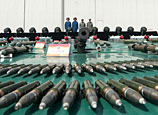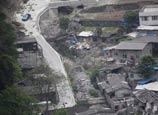
Earthquake detection program to provide seconds' notice of disaster
After experiencing heavy casualties and extensive damage in powerful earthquakes since 2008, China is developing a way to give at least a few extra seconds' warning for those near quake epicenters.
The system, called the National Earthquake Early Warning and Intensity Quick Reporting System, which will have an estimated cost of about 2 billion yuan ($324 million), is expected to be built before 2017 by the China Earthquake Administration — if the National Development and Reform Commission approves the project this year, the administration said.
The administration said the system will detect earthquake-related shaking that are in the form of P-waves, which move rapidly but are harmless, and which arrive before the more-powerful and destructive shear waves, or S-waves.
"As earthquakes cannot be predicted, getting people to safety quickly before the destructive waves arrive can largely decrease casualties," Li Shanyou, deputy director of the Institute of Engineering Mechanics under the China Earthquake Administration, told China Daily.
He added that the few seconds of warning can also help a train driver slow down to avoid possible derailment, warn a doctor to stop a surgery, give a shutdown signal to chemical factories, prevent potential leaks and fires, and alert officials at critical projects, such as nuclear plants.
Experts estimate that casualties could be reduced by 14 percent with a three-second advance warning of an earthquake, and 39 percent with a 10-second warning.
The program includes the construction of more than 5,000 quake-monitoring stations across the country, guaranteeing every city above county level will have at least one. The system will be in four major areas — northern China, the north-south seismic belt, coastal regions of southeastern China, and northwestern Xinjiang Uygur autonomous region — with a station every 25 km.
Li said if quake stations are about 30 km apart, the early-warning system can issue warning information about 10 seconds after a quake happens below ground.
Detecting P-waves with the system can provide a few precious seconds to people before the powerful S-waves arrive.
"The S-waves generally move at a speed of 3.5 km per second, which means before the warning is issued, S-waves have already spread in a radius of 35 km from the epicenter," he said, adding that the area within the 35-km radius of the epicenter, which is called the "blind area", cannot be warned.
Lushan county in the Ya'an earthquake in Sichuan province was in the blind area, Li said.
The early warning cannot play a role in small quakes, but if it is large with a huge affected area, the system will dramatically reduce damage and lead to fewer deaths, he said.
>>>Quake-hit China grows in pain
The principle of sparing no efforts to save lives cannot be more stressed. No minute or even second should be delayed during the "golden rescue period" in the first 72 hours after the quake.
>>>Pilot cancels wedding to participate in quake relief
When the 7.0-magnitude quake happened, Zhang Shangnian, a pilot from an aviation brigade of Chengdu Military Region, was about to hold his wedding.
>>>Nurse returns to work after losing mother
Just likes other medical staff, she was busy with rescuing people injured in the earthquake in SW China, but no one knew her mother just died in the quake.
>>>Wedding ceremony without bridegroom held on schedule
Zhuo Jia, the bridegroom, is a solider of the Chengdu Military Region; he had to leave his beautiful bride behind to participate in earthquake relief.
>>>An injured girl's smile moves many
"Your smile makes the entire world beautiful,” a photo of a smiling girl with bandage on her head has moved so many Chinese netizens.
>>>Teenager saves mom with his bare hands
The mother moves away a precast slab weighing over 50 kilograms alone to save her son in the earthquake. She said she did not know where her strength came from.


















![]()
